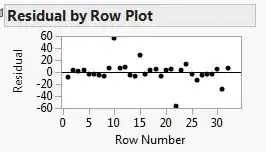As a part of a design of experiments course I'm taking, I ran an experiment at home. The experiment was checking how water boiling time changes under certain factors (5 overall factors) all which had 2 levels: with or without salt, with or without oil, type of pot, type of water and the diameter of the pot. The experiment was a fractional factorial of [2^(5-1)]*2. I ran the analysis an got this residual plot:


I know it's supposed to be random, but it doesn't seem like it.